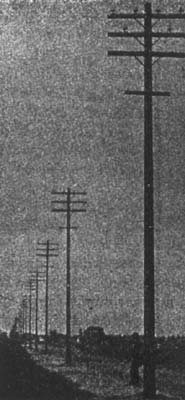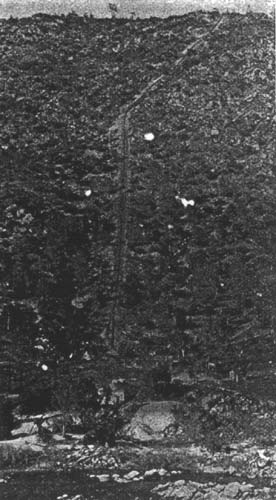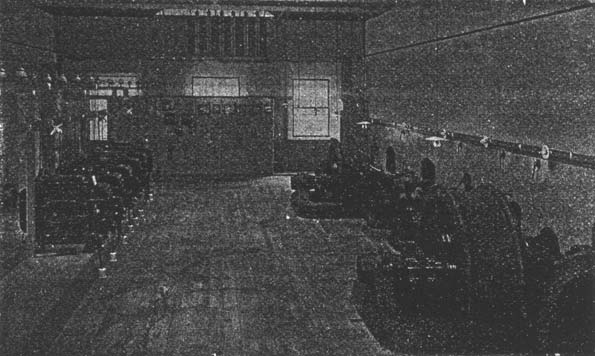[Trade Journal]
Publication: Electrical Doings
New York, NY, United States
vol. 1, no. 5, p. 5, col. 1-3
ELECTRICAL POWER
TRANSMISSION IN THE SAN JOAQUIN
VALLEY.
BY R. B. MULHALL.
In the latter part of June I formed one of a party of four journalists who left the Eastern States for a walking trip through Fresno and Madera counties in California. In the course of my travels through that delightful region, I stopped at the little city of Fresno, which was founded in 1872 in the valley of the San Joaquin river when the Southern Pacific railroad extended its lines to that locality. Fresno is about 206 miles southeast of San Francisco. A short time previous to my visit the little city, which, by the way, has a population of about 13,000 persons, was the scene of the completion of an undertaking which was the result of years of planning and more than a year of active work. I allude to the delivery there of the energy of the San Joaquin river thirty-five miles distant, which is the longest line for the commercial transmission of electricity in the world. The "raisin city," which, like Tacoma, may be regarded as founded by a railway, will shortly celebrate the completion of an electric light and power plant which will place that city on an equal footing as far as power and light are concerned with any city in the East. Its streets will be lighted with lamps of 2,000 candle power each, burning from dusk till dawn every night in the year. Nearly every steam engine in the city will be replaced as soon as the machinery can be put in, and arrangements are now in course of completion to apply electricity to cooking and heating. In short, Fresno bids fair to be the best lighted city in California, and to have the cheapest service in consequence of the water power already alluded to.
| |||
| Reservoir. |
The dry air of California appears to be very suitable to the long transmission of current without leakage over lines whose insulation in moister latitudes might prove sadly inadequate. Owing to the great elevation of the water and the pressure obtainable, it is possible to operate the plant with a stream which, at first, seems insignificant. The source of supply is located among the mountains of Madera county, nearly forty miles from Fresno in an air line, but more than fifty by the road. The north fork of the San Joaquin river, from which the water for running the generators is taken, has its numerous sources among mountains from 5,000 to 12,000 feet high. The minimum low water flow at this point is fifty cubic feet per second. The north fork of the river is formed by several streams which flow through rocky channels before they unite. At an elevation of 2,500 feet the water is taken from the channel by means of a canal which, for some distance, is cut in solid rock along the mountain side and at other places is carried by flumes till it reaches a region less rugged. From there it is continued several miles to the summit of a mountain which juts out in the shape of a promontory over the main bed of the San Joaquin river more than 1,400 feet away.
The reservoir is located on the summit of the mountain 1,600 feet above the river. It is filled with water to a depth of ten feet and covers eight acres. Its capacity can be increased in proportion to requirements. In its present shape it contains sufficient water to drive the machinery of the existing installation thirty days. Ample precautions are taken to guard against the reservoir embankments giving way. In the event of such an accident the machinery need not be stopped, because the reservoir is so constructed that in the event of such a happening it can be dispensed with by reason of a canal which leads around the reservoir and connects directly with the pipe down the mountains.
The chief interest lies not in the canal and reservoir, but in the line of pipe which conveys the water from the reservoir to the big granite power house at the foot of the mountain. This pipe, which carries water own a precipice of 1,410 feet in perpendicular height, is of stronger construction than any boiler of modern make. The steel in the pipe is one-fourth of an inch thick at the upper end, gradually increasing until it reaches the bottom, where it is seven-eighths of an inch. The pressure at the receiver is 610 pounds, to the square inch, exceeding several times the pressure considered dangerous in a steam boiler. At the top the pipe is twenty-four inches in diameter, but as water runs faster under greater pressure, the pipe gradually decreases, until at the receiver it is only twenty inches. Immense wire cables anchor the pipe to the solid rock of the mountain so it cannot slip. The pipe is protected from rust by a coating of asphalt, while a standpipe which is placed near the reservoir and into which air may rush to fill the vacuum in the event of a break occurring in the line precludes the possibility of such a thing as a collapse.
| |||
| The Pole Line. |
The electric plant consists of three general electric three-phase generators each of 350 kilowatt capacity, at a speed of 600 revolutions. Insulated flange couplings connect the armatures to the water wheels. Exciters of the slow speed multipolar variety are used. The switchboard, which is of highly polished Vermont marble, consists of six panels. Three of these are generator panels, one is the exciter, while the remaining two operate the combination of the six transformers and carry special high tension line switches.
The wheels and dynamos are placed in the power house, which is seventy-five feet long by thirty feet wide and is built on a solid bed rock. The nozzles that furnish water for the wheels project out of a large steel receiver, which is placed at the lower end of the pipe. These nozzles are made of phosphor bronze. They are of deflecting pattern with about one inch orifice. The nozzle is fastened into the receiver by a ball and-socket joint, and is so arranged by means of a differential governor that when the water wheel revolves too rapidly the nozzle is deflected, and when the speed falls too low, the nozzle is turned back to deliver its full force against the buckets of the wheel.
The water wheels are fifty-seven inches in diameter. They are fitted with bronze buckets firmly attached to their rims. They also have steel plate centres and fly-wheels five feet in diameter. The general appearance of the wheels is that of heavy circular saws with large cup-like discs. These discs are also made of phosphor bronze and are close together. Although remarkably light, the water wheels are very strong and revolve 600 times a minute. Each dynamo develops 400 horse-power. Space is provided for additional dynamos when-heeded, but the present installation supplies about twice the power required at present.
| |||
| Pipe Line Descending the Hill to the Power House. |
At the city the current is received at the central station, a brick structure 55x45 feet in size, where it passes through various transformers, and is reduced to several voltages. The current for distribution about the business districts is reduced to 200 volts, that for the residential sections is distributed by a 1,000 volt three-phase system, while a 3,000 volt three-phase system furnishes current to the vineyards and power users in the suburbs within a radius of ten miles.
The work of painting the inside of the 1,800 feet of pipe was assumed by a boiler maker from San Francisco, who had to pass through it in order to perform the task. It was found impossible to do the work in the day time, because of the terrific heat made in the pipe by the sun's beam on the metal. At 5 o'clock in the evening the boiler maker began his journey. He constructed a sled that would pass through the pipe from the top. This he loaded with candles, food, water, paint and brushes. It was also equipped with ropes and pulleys to control the journey. A current of fresh air was then drawn through the pipe and nothing more was seen of the painter until 3 o'clock the next morning, when he emerged from the lower end of the pipe safe and sound. The pipe was afterwards covered with earth to keep off the sun's rays and prevent expansion and contraction as much as possible.
| |||
| Switchboard in the Power House. |
So perfectly is all the machinery in the power house adjusted that with the exception of the roar of water on the wheels scarcely a sound is heard. There is not a cog nor a belt in the building. After its energy has been converted into electric current the water flows off to be used for irrigation purposes.




